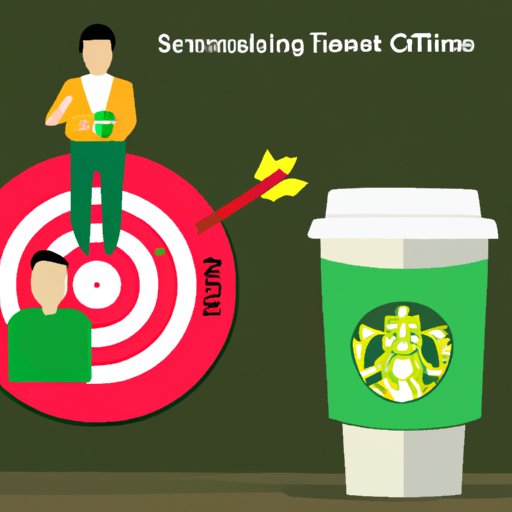Introduction
Starbucks is one of the world’s most recognizable and successful brands. With more than 29,000 stores worldwide, it is an iconic symbol of the coffee industry. But how did the company become so successful? This article will explore Starbucks’ marketing strategy and analyze its brand positioning, digital presence, target audience and competitive advantage.
Analyzing Starbucks’ Brand Positioning and Strategy
Starbucks’ brand positioning and strategy have been key to its success. The company’s core values include “excellence, respect for others, responsibility, integrity and fun.” These values are reflected in its mission statement, which states: “To inspire and nurture the human spirit – one person, one cup and one neighborhood at a time.”
The company has also differentiated itself from competitors by focusing on providing high-quality products and superior customer service. Its commitment to quality has enabled it to create a strong bond with customers and build loyalty. According to a study by Cone Communications, 85% of Starbucks’ customers are loyal to the brand.
Starbucks’ target market is primarily affluent young adults between the ages of 18 and 35. The company has used its branding and marketing campaigns to appeal to this demographic, as well as to older generations who may appreciate its premium products.
Examining the Impact of Digital Marketing on Starbucks’ Growth
Starbucks has leveraged technology to expand its reach and drive sales. Its mobile app allows customers to order and pay for their drinks in advance, while its website provides detailed information about its products and services. The company also uses social media platforms such as Facebook, Instagram, Twitter and YouTube to engage with customers and promote its products.
Starbucks’ use of technology in its marketing efforts has paid off. In 2018, its mobile app accounted for 30% of all transactions in the United States. Additionally, the company’s social media presence has grown significantly over the years, reaching nearly 80 million followers across its various platforms.
Exploring Starbucks’ Social Media Presence and Strategies
Starbucks has a strong presence on social media. It uses a variety of platforms including Facebook, Instagram, Twitter and YouTube. On these platforms, the company posts content related to its products, promotions and events. Additionally, it engages with its customers by responding to comments and messages, and sharing user-generated content.
The types of content Starbucks typically posts include photos, videos, articles and polls. The company also uses hashtags to increase the visibility of its posts and encourage engagement. For example, the hashtag #StarbucksCupStories was used to promote the company’s reusable cup program.
In addition to posting content, Starbucks also uses social media to listen to customers and respond to their feedback. For example, the company has a dedicated team that monitors social media channels for customer complaints and responds to them promptly.
Assessing Starbucks’ Target Audience and Tactics
Starbucks’ primary target audience is young adults between the ages of 18 and 35. The company uses a variety of tactics to reach this demographic, including advertising, sponsorships, promotions and product placement. Additionally, it has partnered with popular influencers to promote its products and increase brand awareness.
To further engage its target audience, Starbucks has created interactive campaigns such as the “My Starbucks Idea” platform, which encourages customers to submit ideas for improving the company’s products and services. Additionally, the company has launched initiatives such as the “Meet Me at Starbucks” campaign to connect customers with like-minded individuals.
Investigating Starbucks’ Pricing Strategy and Competitive Advantage
Starbucks’ pricing strategy is based on a premium pricing model. The company’s prices are higher than those of its competitors, but its customers are willing to pay a premium for its products due to their perceived value. Additionally, the company has a competitive advantage due to its widespread presence, strong brand recognition and innovative products.
Starbucks also has a unique selling point: its loyalty program. The program rewards customers with discounts and free drinks for making purchases, and encourages them to return to the store. Additionally, the company leverages its loyalty program to collect customer data, which it uses to tailor its marketing strategies.
Conclusion
Starbucks’ marketing strategy is based on its core values, differentiation, digital presence, target audience and unique selling point. The company has leveraged technology to expand its reach and drive sales, and has used social media to engage with customers and promote its products. Additionally, it has a loyal customer base due to its focus on quality, pricing model and loyalty program.
This article has provided an overview of Starbucks’ marketing strategy. Further research could explore the company’s international expansion and its use of technology in greater detail. Nonetheless, it is clear that Starbucks’ success can be attributed to its effective marketing strategies.
(Note: Is this article not meeting your expectations? Do you have knowledge or insights to share? Unlock new opportunities and expand your reach by joining our authors team. Click Registration to join us and share your expertise with our readers.)
